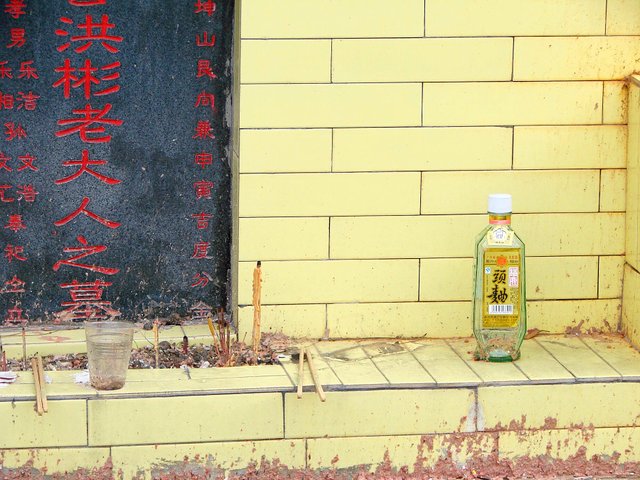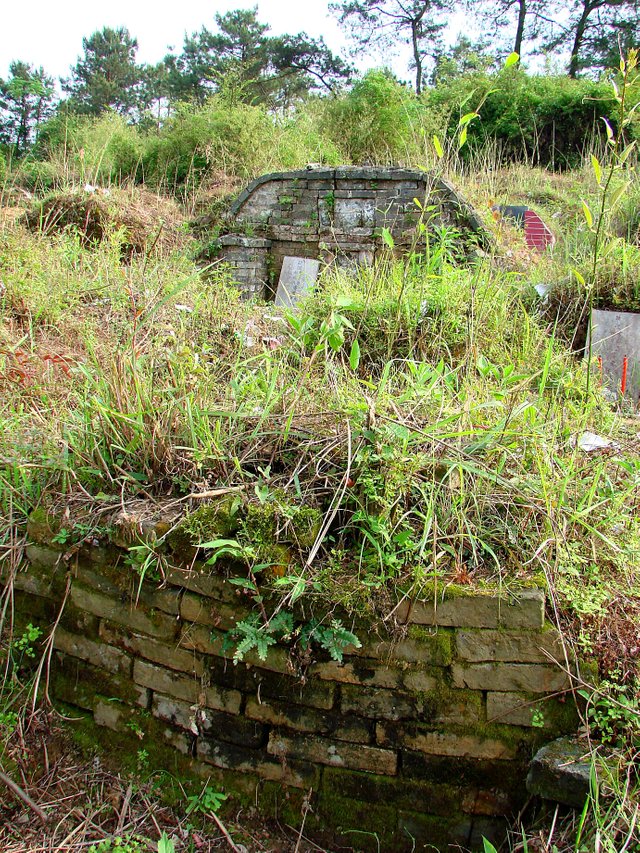| In my last "Cycling Shaoguan" post I already mentioned the public cemetery I had found & that on a hill nearby there was another less official graveyard. Because the latter is very interesting in & of itself & provided lots of pictures, this post is entirely devoted to it. | In meinem letzten Beitrag zum "Umgebungsradeln" erwähnte ich bereits den öffentlichen Friedhof, den ich gefunden hatte & den nahegelegenen nicht ganz so offiziellen. Da letzterer sehr interessant ist & sehr viele Bilder lieferte, ist ihm dieser Artikel komplett gewidmet. |
|---|

| This cemetery, which is most probably a graveyard where the local farmers bury their dead, is seemingly simply a hill on which people dig the graves as they see fit. The look may be misleading, though, since members of Chinese families or clans tend to prefer being buried in close proximity. | Dieser Friedhof, der wohl hauptsächlich von lokalen Farmern genutzt wurde, scheint einfach nur ein Hügel zu sein, auf dem die Leute nach Gutdünken Gräber anlegen. Das kann jedoch täuschen, da Mitglieder chinesischer Familien oder Klans bevorzugt nahe beieinander begraben werden. |
|---|

| Anyway, it is very different from the public cemetery on the hill beyond the fishpond. Which is clearly delimited & the tombs are put in neat rows all around the hill. | Auf jeden Fall sieht es dort ganz anders aus als auf dem öffentlichen Friedhof auf der anderen Seite des Fischteichs. Jener ist klar abgegrenzt & die Gräber schön aufgereiht. |
|---|

| The unofficial graveyard doesn't even have proper footpaths & the graves are dug directly into the hillside. Well, dug ... I'm not really sure about that, at least in regards to this particular cemetery. Could be that the dead body is just layed on the ground & the grave is built on top of it. Many of the graves there looked like that & although I looked for websites explaining how Chinese dig their graves, I haven't found anything (yet). | Der inoffizielle Friedhof hat nicht mal richtig Fußpfade & die Gräber wurden direkt in den Hügel gegraben. Nunja, gegraben ... Bin mir da nicht sicher, zumindest in diesem speziellen Fall. Kann sein, daß die Leichen einfach auf die Erde gelegt wurden & das Grab darüber erichtet wurde. Viele der dortigen Gräber sahen jedenfalls so aus & obwohl ich gesucht habe, konnte ich keine Infos darüber finden, wie die Chinesen ihre Gräber graben. |
|---|

| Below in the upper left, you can see the most elaborate tomb on this hill. The style is very much like the tombs of wealthier people, but the materials & the finish show that, in this case, it is just relative wealth. & you can see why I get the impression that they had not dug holes for their graves. Although, maybe they did & then built a small hill on top. | Auf dem Bild unten sieht man oben links die bestausgebaute Grabstätte auf diesem Hügel. Der Stil entspricht dem wohlhabenderer Leute, aber die Materialien & das Finish zeigen, daß es sich hier wohl eher um relativen Wohlstand handelte. & man sieht, warum ich den Eindruck habe, daß dort keine Löcher gegraben wurden. Kann natürlich sein, daß man es doch tat & dann einen kleinen Hügel darüber errichtete. |
|---|

| At the foot of the hill was this building, which might have been used to cremate bodies before burial. But it could also be just a small factory of some kind. I didn't really check. | Am Fuß des Hügels stand dieses Gebäude, das vielleicht als Krematorium diente. Könnte aber auch nur eine Art Fabrik gewesen sein. Habe nicht nachgeguckt. |
|---|

| Climbing onto the hill, the first grave I encountered was the one from the title photo, with behind it 2 less elaborate ones: | Auf dem Hügel selbst sah ich als erstes das Grab vom Titelbild, dahinter 2 weniger gut ausgebaute: |
|---|

| The corresponding style of the tombstones & engravings suggests that they belong to one family. Since I can't really read Chinese characters, though, I can't be sure. The white pieces of paper on the graves are symbols of mourning & are usually put there during tomb sweeping day (qingming). The stuff on the ground between the graves is mostly just garbage (so much for tomb sweeping). | Da Grabsteine & Gravur gleichartig sind, ist anzunehmen, daß es Angehörige einer Familie waren. Da ich keine chinesischen Zeichen lesen kann, bin ich mir aber nicht sicher. Die weißen Papierfetzen auf den Gräbern sind Symbole der Trauer & werden normalerweise zum Qingming-Fest (auf Englisch auch Grabfegefest genannt) angebracht. Das Zeug zwischen den Gräbern ist hauptsächlich Müll (von wegen fegen). |
|---|

| Above are again graves seemingly belonging to one family, but in this case obviously a rather poor one. They could only afford gravestones, no proper tomb. There are people which are even worse off, though: | Oben sieht man wieder Grabstätten, die offenbar zu einer Familie gehören, allerdings hier wohl einer recht armen. Man konnte sich nur Grabsteine leisten, keinen gemauerten Vorbau. Es gibt aber auch noch Ärmere: |
|---|

| This is a single grave without even a grave stone, completely surrounded by shrubs. As you can see from the incense sticks, though, it is not forgotten. Family still pays their respect. | Ein einzelnes Grab, sogar ohne Grabstein, im Gebüsch verborgen. Wie man an den Räucherstäbchen sehen kann, wurde es aber nicht vergessen. Die Ahnen wurden immer noch verehrt. |
|---|

| That's another such grave. The empty plastic cups to the right of it probably contained Chinese brandy as a kind of offering. Chinese not only honour their ancestors, they also fear them. Offerings are supposed to keep them in good spirits. | Noch ein solches Grab. Die leeren Plastikbecher rechts unten enthielten wahrscheinlich chinesischen Schnaps als Opfergabe. Man ehrt die Ahnen nicht nur, sondern fürchtet sie auch. Opfergaben sollen sie bei guter Stimmung halten. |
|---|

| A more elaborate tomb again. In front of the usual incense sticks, this time with some additional mandarin oranges as offering. The red paper on the ground is what's left of fireworks. I don't remember the significance of the red cloth on a stick beside the grave. | Wieder eine deutlich besser ausgebautes Grab. Davor sieht man die üblichen Räucherstäbchen, diesmal mit Mandarinen als zusätzlicher Opfergabe. Bei dem roten Papier auf dem Boden handelt es sich um Feuerwerksreste. Was das rote Tuch rechts oben bedeuten soll, habe ich leider vergessen. |
|---|

| This one's interesting because it looks like they were very poor, but still tried to build a proper grave. With limited success, though. It seems to be rather old, but - again - judging from the rather fresh white paper, it is still looked after. | Das obige Grab ist interessant, da es aussieht, als ob man trotz großer Armut versucht hat, ein ordentliches Grab zu errichten. Allerdings mit mäßigem Erfolg. Es scheint recht alt zu sein, aber wurde vermutlich noch "gepflegt", wie man am weißen Papier sieht. |
|---|

| Here you see a single proper tomb, surrounded by unmarked graves. I suspect, that was a poor family who put all their money in that one tomb to have a place of worship for all dead ancestors. (Or that was the 1st family member with enough money to build one.) | Hier sieht man ein einzelnes, ordentlich ausgebautes Grab, umgeben von einfachsten Erdgräbern. Mir scheint, dieses gehört einer armen Familie, die ihr ganzes Geld in eine vernünftige Grabstätte gesteckt hat, um einen Platz der Ahnenverehrung für die ganze Familie zu haben. (Oder dies war das erste Familienmitglied mit genug Geld für eine Gruft.) |
|---|

| This one shows an effort to get close to a complete tomb. They didn't only build the front, but also surrounded the backside with a kind of wall. For what I know, a really complete tomb would have the grave totally enclosed. | Dieses zeigt den Versuch, eine komplette Gruft zu bauen. Man hat nicht nur die Vorderseite gebaut, sondern auch den Erdhügel ummauert, wenn auch nur an den Seiten. Wenn ich das richtig sehe, sollte eine wirklich vollständige Gruft komplett geschlossen sein. |
|---|

| Seems to be a rather old grave, almost totally overgrown. But yet, it doesn't seem to be completely forgotten. On top you can see some pieces of white paper. There are no incense sticks or other offerings, though. | Scheint ein ziemlich altes Grab zu sein, fast total überwachsen. Dennoch scheint es nicht völlig vergessen zu sein. Oben sieht man einige Fetzen weißen Papiers. Allerdings gibt es keine Räucherstäbchen oder andere Opfergaben. |
|---|

| The above shows signs of fire. But that is most probably not vandalism. In #China it is tradition to burn paper money or worldly possessions made of paper, so that the dead can use it in the afterlife. Usually that's done at home or on street corners, though. | Um das obige Grab hat es gebrannt. Muß aber kein Vandalismus sein. Traditionell werden in China Papiergeld & andere weltliche Besitztümer in Papierform verbrannt, damit die Verstorbenen diese im Jenseits nutzen können. Gewöhnlich passiert dies aber zuhause oder an Straßenecken. |
|---|

| That tomb is a bit strange. It seems they built 2 tombs together with 1 person on the left & 2 on the right. Have no idea as to why. | Dieses Grab ist etwas seltsam, da es anscheinend aus 2 aneinandergebauten Gräbern besteht. Rechts liegen wohl 2 Personen & links eine. Keine Ahnung, warum. |
|---|


| A better tomb with the usual offerings. This time not only cups with bai jiu (Chinese brandy), but also an - albeit small - bottle. Some poorer people do just the same: | Ein besseres Grab mit den normalen Opfergaben. Diesmal nicht nur Becher mit Baijiu (chinesischer Schnaps), sondern dazu eine ganze, wenn auch kleine Flasche. |
|---|


| Only in this case the brandy seems to be from a cheaper brand. | Eine ärmere Familie brachte auch eine Flasche Baijiu als Opfergabe. Nur scheint der Schnaps hier eine billigere Marke zu sein. |
|---|---|
| For more info on Chinese funerals & burials: | Mehr Infos über chinesische Begräbnisse (alles auf Englisch): |
http://www.sixthtone.com/news/1003043/to-religious-chinese%2C-cemeteries-are-of-grave-importance
https://www.funeralwise.com/customs/chinese/
https://en.wikipedia.org/wiki/Chinese_funeral_rituals
https://beyondthedash.com/blog/cultural-spotlight/chinese-funeral-traditions/6346
https://en.wikipedia.org/wiki/Ancestor_veneration_in_China#Burial
| & now just a few more pics: | Nur noch ein paar Bilder: |
|---|












Congratulations, your post was discovered and featured by @OCD in its daily compilation #420!
If you give @ocd a follow – you can find other Gems!
Check our website for the more information about our #newsteem attitude. Join our Discord channel to be part of our community
We also have a witness. You can vote for @ocd-witness with SteemConnect or on Steemit Witnesses to help support other undervalued authors!
Downvoting a post can decrease pending rewards and make it less visible. Common reasons:
Submit
Thanks!
Downvoting a post can decrease pending rewards and make it less visible. Common reasons:
Submit
Einen sehr interessanten Artikel über Friedhöfe hast du geschrieben.
Es ist beeindruckend, wie die Leute ihren Verstorbenen gedenken.
Viele Grüße.
Downvoting a post can decrease pending rewards and make it less visible. Common reasons:
Submit
Danke!
Downvoting a post can decrease pending rewards and make it less visible. Common reasons:
Submit
Hallo ich bin Mikrobi,
dein Beitrag hat mir sehr gut gefallen und du bekommst von mir Upvote.
Ich bin ein Testbot, wenn ich alles richtig gemacht habe, findest du deinen Beitrag in meinem Report wieder.
LG
Mikrobi
Downvoting a post can decrease pending rewards and make it less visible. Common reasons:
Submit
Mit Glueck ein !BEER und ein Upvote..... Grund zur Freude
Downvoting a post can decrease pending rewards and make it less visible. Common reasons:
Submit